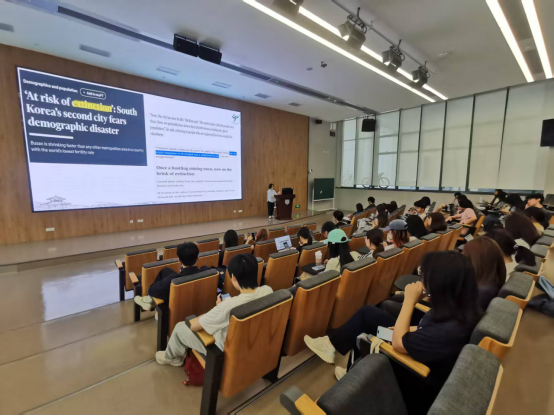On the morning of June 6th, 2025, the Business School of Shenzhen Technology University hosted a lecture in Room C5-106. With the support of the Resset Database, the lecture was designed to enhance students' proficiency in data application.
The theme of the lecture was "Shrinking Cities During Urbanization." Professor Regina Fang-Ying Lin from the Business Schoolhost the event, while Professor Liqun Pan from the School of Economics and Statistics at Guangzhou University delivered the speech. Together with marketing students from the 2024 cohort, they delved into the development disparities between large and small/medium-sized cities in Asia, as well as strategies to address the issue of shrinking cities.
At the outset, Professor Pan employed real-world examples to illustrate the pronounced imbalance in urban and rural development across Asia. She highlighted that Japan boasts over 10 million vacant houses, Busan in South Korea is experiencing rapid population depletion, and China’s Northeast has witnessed a population decline. By juxtaposing Tokyo’s population growth (from 13% in 1945 to 30% currently) with the population loss in smaller cities, she posed thought-provoking questions: What accounts for the stark differences between large and small cities? Is urban shrinkage an inevitable phenomenon?
Subsequently, Professor Pan expounded on three pivotal concepts. Firstly, she emphasized the severity of "urban growth divergence" in Asia, where large cities thrive while smaller ones dwindle due to population outflows and closed-off societies. Secondly, she noted that cities in the West and East adhere to distinct life cycles, yet both exhibit a trend of people migrating to large urban centers. Thirdly, she cited Japanese data to substantiate Zipf’s Law, which posits that cities are becoming increasingly unequal, with larger cities exerting greater dominance.
When discussing potential solutions, Professor Pan cited Busan’s 2014 urban renewal initiative as a case study. Transforming old train stations into cultural and commercial hubs resulted in a notable increase in the working-age population (a statistically significant outcome), albeit with limited impact on business growth or job creation. This underscored the notion that while cultural projects can offer short-term benefits, achieving long-term economic revitalization remains a formidable challenge.
In conclusion, Professor Pan asserted that the gap between urban and rural areas will continue to widen as a natural consequence of urbanization. While it may be impossible to completely halt urban shrinkage, targeted renewal plans can mitigate local declines. The lecture drew upon examples and data from various countries to foster a deeper understanding of shrinking cities in Asia and encourage participants to contemplate strategies for sustainable urban development.

Photo 1.Group Photo
Photo: Regina Fang-Ying Lin
Text: Huihui Gao, Shiying Su
Review: Regina Fang-Ying Lin